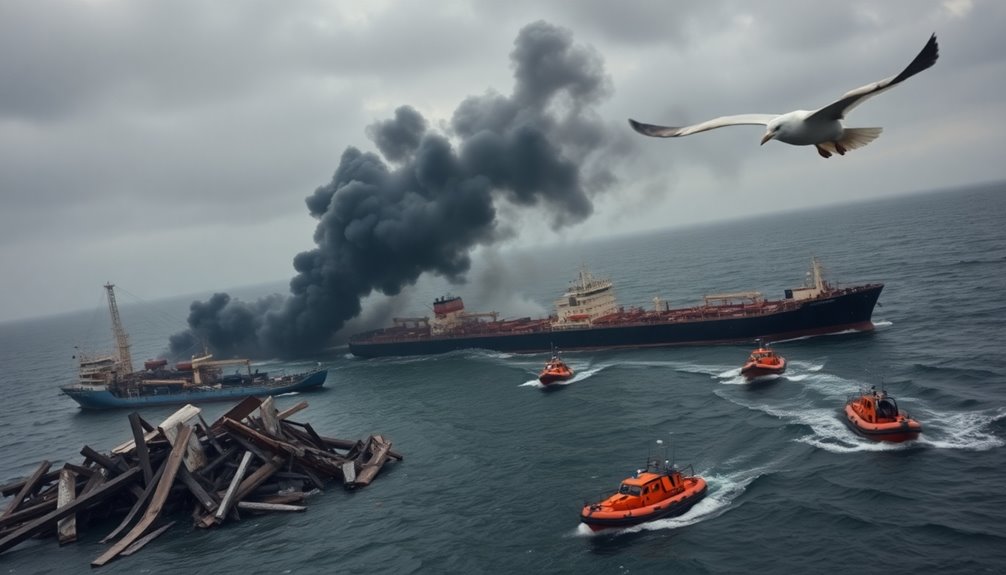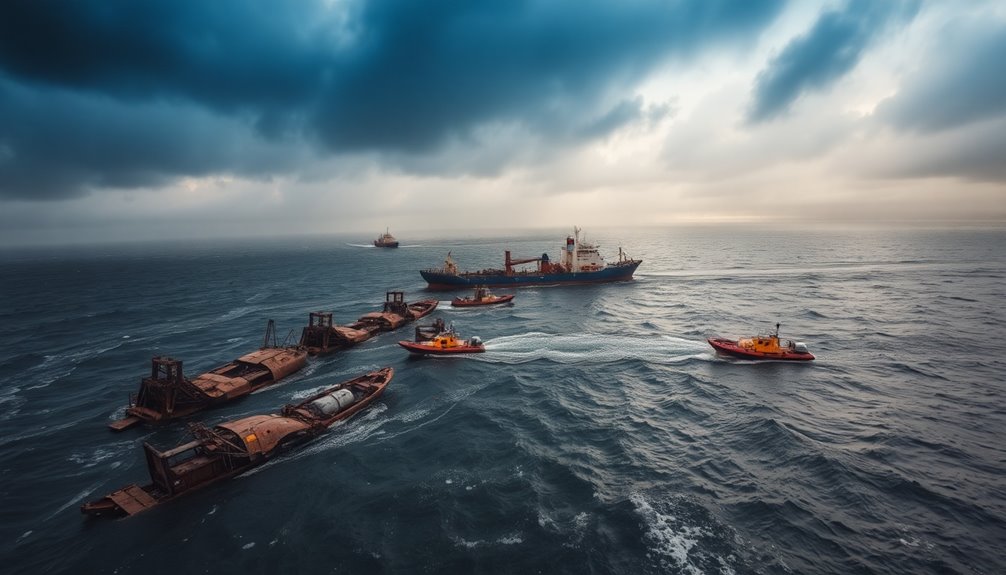The North Sea tanker crash raises serious questions about accountability. Investigations reveal that the Portuguese-flagged Solong has a history of safety violations, and its Russian captain faces arrest for gross negligence. Both vessels may have failed to maintain proper lookout practices, adding to the complexity of blame. With a massive fuel spill and environmental concerns at stake, the situation demands strict scrutiny. There's much more to uncover regarding the implications for maritime safety regulations and accountability.
Key Takeaways
- The Russian captain of the Solong is facing charges of gross negligence manslaughter, raising questions about his responsibility for the collision.
- Previous safety inspection failures and steering equipment issues on Solong may indicate systemic negligence contributing to the crash.
- Both vessels' adherence to maritime regulations and proper lookout practices during the incident are under scrutiny, complicating fault determination.
- The activated status of AIS technology on both vessels is unclear, which could affect accountability regarding navigation safety.
- Ongoing criminal investigations and potential regulatory changes highlight the complex nature of fault in maritime incidents.

On a fateful day in October 2023, the North Sea tanker crash unfolded when the Portuguese-flagged cargo vessel Solong collided with the U.S.-flagged oil tanker Stena Immaculate, which was anchored off East Yorkshire. The Stena Immaculate was waiting for a berth at the Humber Estuary when disaster struck. The collision led to multiple explosions and a fierce fire, leaving one sailor missing and presumed dead amid the chaos. With a total of 36 crew members rescued, the incident sparked questions about accountability and safety protocols.
A catastrophic tanker collision in the North Sea raises urgent questions about maritime safety and accountability.
Investigations revealed that the Solong had a troubled past, having failed safety inspections before. Issues with steering equipment and alarms raised red flags, yet the vessel remained operational. The collision's circumstances raise concerns about whether proper lookout practices were in place. Both vessels were equipped with AIS technology, but it's unclear if it was activated during the incident. This ambiguity complicates the question of fault and negligence.
The Solong's Russian captain faced arrest on suspicion of gross negligence manslaughter, intensifying scrutiny on his actions. Maritime regulations demand adherence to safety standards, and violations can have severe repercussions. The ongoing criminal investigation led by Humberside Police, alongside the Marine Accident Investigation Branch, aims to shed light on the disaster's causes.
Environmental concerns loom as well, with jet fuel carrying 35 million litres spilling into the North Sea. While the fuel evaporates quickly, the potential for ecological damage remains significant. As assessments continue, the focus on mitigating environmental impacts becomes increasingly crucial.
As authorities probe deeper into the incident, you can sense the high-stakes fight brewing over accountability. Will the Solong's captain bear the brunt of the blame, or will other factors come into play? This crash isn't just about the vessels involved; it's a wake-up call for maritime safety regulations and their enforcement. The world watches, awaiting answers.
Frequently Asked Questions
What Were the Weather Conditions During the North Sea Tanker Crash?
During the North Sea tanker crash, you'd find that strong winds and rough waves characterized the weather.
These conditions, common in the area, could've impacted navigation and visibility, even though the incident occurred in daylight.
The wind likely caused significant drift of surface objects, potentially influencing the spread of pollutants.
How Are Tanker Accidents Typically Investigated?
When you think of tanker accidents, you might picture chaos and confusion, but investigations aim for clarity and order.
Typically, you'll find agencies interviewing crew members, analyzing vessel logs, and collecting communication records. They assess damage on-site and gather witness statements to piece together what happened.
Data recorders, like black boxes, provide crucial insights. These findings not only clarify incidents but also shape future maritime safety regulations to prevent similar tragedies.
What Are the Potential Environmental Impacts of a Tanker Crash?
A tanker crash can have severe environmental impacts.
You'll see risks to marine ecosystems, particularly for vulnerable species like harbor porpoises and seabirds, which can suffer from toxic spills.
The type of fuel spilled plays a crucial role; lighter fuels may evaporate quickly, but heavier ones can linger and cause long-lasting damage.
The extent of the impact often depends on factors like spill size, weather conditions, and the effectiveness of the cleanup response.
How Can Similar Accidents Be Prevented in the Future?
You'd think with all the technology, accidents wouldn't happen, right?
To prevent similar incidents in the future, you need to prioritize crew training and effective communication. Regular maintenance of equipment is crucial, as is investing in advanced navigation systems.
Implementing stricter safety inspections and encouraging a culture of reporting near misses can enhance safety.
Lastly, consider integrating AI to assist decision-making—after all, it's better to let machines handle the heavy lifting sometimes!
What Legal Repercussions Can Arise From a Tanker Collision?
In a tanker collision, you could face various legal repercussions.
If negligence is proven, you might be liable for damages, including medical expenses and environmental cleanup.
Should your vessel be deemed unseaworthy, you could face claims without needing to prove fault.
Additionally, if third-party actions contributed to the accident, they might also be held accountable.
Ultimately, navigating these complexities requires understanding liability, compensation claims, and potential regulatory actions.
Conclusion
As the investigation unfolds, you can't shake the feeling that more than just a collision is at stake. With each new piece of evidence, tensions rise, and fingers point in every direction. Was it human error, a mechanical failure, or something more sinister? Every detail you uncover pulls you deeper into a web of intrigue and blame. Just when you think you've pieced it all together, another twist leaves you questioning everything. What'll happen next? You'll have to wait and see.









